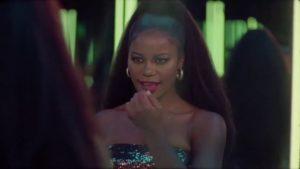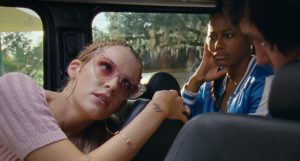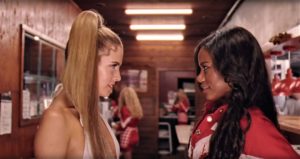'Easy A' Is Pretty Anti Sex
'Easy A' is emblematic of a world that liked to sarcastically pretend it was progressive but wasn’t actually ready for that change, making it pretty anti-sex.
Incluvie Foundation Gala - Learn More


Zola as an experience was very consecutive for me. I saw both the trailer and poster two days before it released, and being anxious to throw myself into a theater, I was more than on board.
I sat down for the hour and a half, came home, and at first gave a resounding:
“… Yeah, that was pretty good”.
As days went on, the film continued to flash past my mind, each time leaving me with a different piece of a larger viewpoint. It took me a few days to fully sit with the many intersections being touched both on and off-screen and the many things that are said in this short runtime. Now, being on the other side of this deliberation, I not only find the movie to be a super fun time, but also a glimpse to the possible future of modern black parables.

When I say modern black parables, I’m referring to the recent uproar of films that aim to teach about the black experience: Loving, Queen and Slim, and If Beale Street Could Talk, to name a few. What makes these different from the current black horror craze is that although they both want to address struggles of blackhood, the modern black parable is shooting for a more stripped-down, realistic story. Most black people wouldn’t agree that they’ve been kidnapped to cosplay as a slave ala Antebellum, but they have experienced racial tensions similar to what we saw in The Hate You Give. So, when you put like that, it’s not difficult to see how Zola has earned its position among the ranks. The movie is based on a real story, turned twitter thread, turn Rolling Stones article. If any of you have read it, I think you’d agree it’s hard to get more honest and raw than that. However, I think we would also agree that there is a hesitation to put Zola in with these other films.
Yes, on one hand, the modern black parables have the underlining “real people doing real things” tone, but Zola creates a very different mood than the others. For example, a lot of these films have wide shots of large terrains as a way to literally show you the size of the story. But Zola very purposefully takes place indoors in buildings that are small and confining. Where a film like Queen and Slim will curate the perfect soundtrack to capture the spirit of a people, Zola sounds like turning on the radio around 2 in the morning. All of these creative decisions curate a different experience for each film. In truth, when you study the work, Zola is less Bible and more Rapunzel. Less parable, more fairytale.

In some ways this does seem obvious; Zola continuously uses shorthand to fairytale motifs. Its glittery filters, dreamy narration, dress up sequences, and sound effects remind you of being 6 years old. And it’s easy to digest these moments as style — something added to give the film a visual identity. But I’ve traded in that lens and now view it the same as I would a story from the Brothers Grimm. A lot of their tales centered on averting from danger by staying clear of things that are enticing, but also deadly. Keep clear of the witch’s candy house, don’t attempt to have children in unnatural ways, work hard to go to the ball, and the list goes on. The Grimm collection, along with most prolific folktales, use whimsy and charming imagery to warn us of unforeseeable dangers. And that energy is mimicked in the choices for this movie. The plot really is about one bad night, and how Zola would have never been put in that position had she paid attention to the warning signs. As a narrator, she comedically points the audience toward these red flags, almost as if this really was from Hans Christian himself.
One gigantic plus Zola‘s message is that the caution is not sex work itself. There’s no giant cry scene or women being beaten for a pint of coke. Sex work is presented as what it is: work. Unlike most films featuring sex work, Zola shows more scenes of women preparing to perform their job than them simply being sexy, which does wonders at giving them a higher sense of capability and more well-rounded personalities. Two who were particularly enjoyable were the stripper who prayed for sad ugly men and Zola herself. At one point, she performs the job of a pimp and makes thousands of dollars by effectively understanding the market and what she could get from it. I think this addition was the perfect way to communicate that the big bad here isn’t the industry itself, but these particular people. Which, speaking of, is my favorite aspect of the picture, and what ties us back to blackness. Because the thing to fear here isn’t the monster under the bed or being a stripper, but rather friendships with white women and how they can weaponize their whiteness.

Stefani is our deuteragonist, and a complex one at that. Ironically, toward the beginning of the story, her backstory hits all the traditional beats I said the film is evading. She’s got a psychotic killer as a pimp, a slow to the pickup boyfriend, and a baby who she’s supposedly doing all of this for. However, as the film continues, her backstory and character become a lot shakier. Her relationship with her pimp starts to look a little less controlling and a little more like an unfair partnership. She’s actively emotionally manipulative with her man, even going as far as to scoff at his suicide attempt. And in one particularly heated argument, said boyfriend reveals that Stefani is lying to Zola and that she’s done this before with other girls. We as the viewers are seeing all of this unfold from Zola’s perspective. Our understanding of Stefani becomes richer along with her. This film is authentic in how it captures friendships with white people from a black perspective. A lot of times there is a period where a lot of your new white friends’ behaviors feel bizarre, and you can’t really make sense of why they make the choices that they do. It doesn’t mean that you like or dislike them any less, but rather the two of you are from different cultures, and you’re just starting the process of coexisting with theirs. Those things on their own are questionable, but not dubious. Stefani’s insistence on doing the most isn’t what makes you leave the theater disliking her — that honor is in how she describes her relationship with Zola.

The strongest part of the film by far is the Stefani narration bit. As I noted, the film thus far has been playing out with Zola being the narrator, and thus from Zola’s point of view. So, we meet Stefani how she meets Stefani. We see her awkward attempts at AAVE, her blatant reliance on colorism and cultural appropriation, the way she gleefully leans into being a sex worker, and her need to twist people into helping her by lying to them. But halfway into the film, literally spliced right before a gang bang she started, we see her recount everything we’ve seen so far but in an obviously distorted sense. According to her, she’s just your usual God-fearing church girl and one day the trashy, ghetto Zola walked up to her in a Hooters and forced Stefani to watch over her while she pimped herself out. First off, this scene is amazingly hilarious for it’s set up. It’s in the little details, like how she envisions Zola coming to the poles in a literal trash bag, and also the fact that while she’s telling this, she can’t help but repeatedly call Zola hideous. More importantly, it shines a light on the power imbalance of their friendship. Although we as the audience get to see the truth and know Stefani is doing a bad job at lying, in reality, most of society would still believe her because she is white. And so, it doesn’t matter whether or not Stefani means it when she tells Zola that she loves her and that she’s her best friend, because when she’s pinned up against a wall, she has no problem pulling out her race card.
I don’t believe the film is trying to suggest that having white friends in general is a no-go. Rather, its message is to be cautious with which ones you leave yourself vulnerable to. Because, for all the performative downness Stefani does, for all the aligning herself with black culture, we also see her being acutely aware of the fact that she’s still a white girl. And if she needs to, she can use that against anyone she crosses. I think this film does a strong job of showing the muddy waters that can appear in. It’s not always some random Karen who’s upset about last morning’s latte; sometimes it’s the people who know you and have known you for a long time. But, as I’ve said, the film doesn’t address this didactically. It’s fun, it’s energetic, but it’s also understated and vicarial. It’s like a modern black fairytale for grownups, and personally, I hope it’s indicative of more like this to come.
Related lists created by the same author
'Easy A' is emblematic of a world that liked to sarcastically pretend it was progressive but wasn’t actually ready for that change, making it pretty anti-sex.